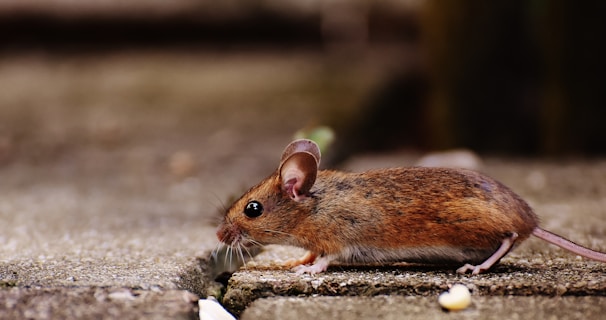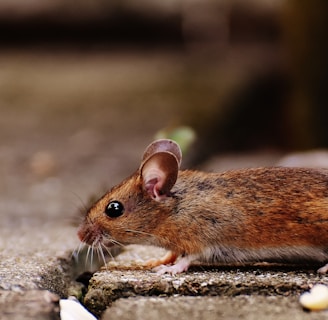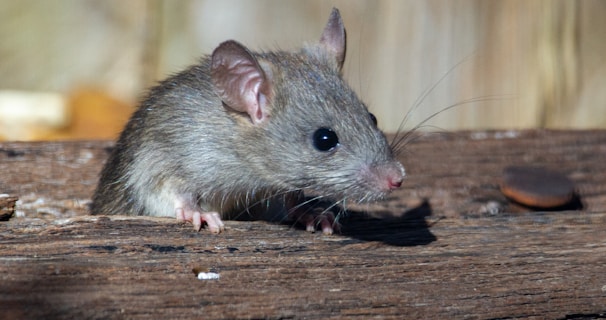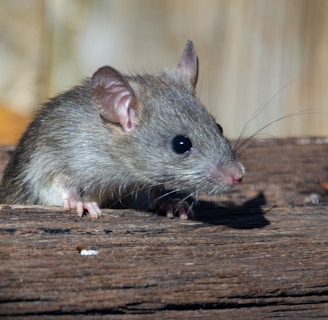Dealing with Complex Rodent Control Situations
Navigate Complex Rodent Control Challenges with Precision: Discover Our Strategic Approach for Effective Solutions. Call today (401) 390-2080 for a free quote!
COMMERCIAL PEST CONTROLRAT CONTROLMICE CONTROLNE REGION PEST CONTROLRESIDENTIAL PEST CONTROLPEST CONTROL
NERPC
1/2/202413 min read


One of the first steps in developing a strategic approach to rodent control is to conduct a thorough inspection of your property. This will help you identify the areas where rodents are likely to be nesting or accessing your property. Look for signs of rodent activity such as droppings, gnaw marks, and tracks. Pay special attention to areas that provide food, water, and shelter for rodents, such as garbage cans, compost piles, and overgrown vegetation.
Once you have identified the problem areas, it is important to take proactive measures to prevent rodents from entering your property. This may involve sealing cracks and holes in your walls, floors, and foundation, as well as installing screens on windows and vents. Additionally, make sure to keep your property clean and free of clutter, as rodents are attracted to areas that provide hiding places.
In addition to prevention, it is crucial to implement effective control measures to eliminate existing rodent populations. Traditional methods such as traps and baits can be effective, but they may not be sufficient for complex rodent control situations. In these cases, it may be necessary to consider alternative methods such as using ultrasonic devices or employing the services of a professional pest control company.
When choosing a rodent control method, it is important to consider the safety of your family and pets. Some rodenticides and traps can be harmful if not used properly, so be sure to read and follow the instructions carefully. If you are unsure about how to safely use a particular product or method, consult with a professional.
Lastly, it is important to monitor the effectiveness of your rodent control efforts and make adjustments as necessary. Rodents can be resilient and adapt to changes in their environment, so it may take time and persistence to completely eliminate them from your property. Regularly inspect your property for signs of rodent activity and make any necessary changes to your control strategy.
By taking a strategic approach to rodent control, you can effectively eliminate these pests from your property and prevent future infestations. Remember to be proactive in preventing rodents from entering your property, choose control methods that are safe and effective, and regularly monitor the effectiveness of your efforts. With these strategies in place, you can regain control of your property and enjoy a rodent-free environment.
1. Thorough Inspection
The first step in any rodent control strategy is to conduct a thorough inspection of your property. This inspection will help you identify entry points, nesting areas, and signs of rodent activity. Look for small holes or gaps in walls, floors, and foundations that rodents could use to gain access to your building. Pay attention to areas such as attics, basements, and crawl spaces, as these are common nesting areas for rodents.
During the inspection, take note of any droppings, gnaw marks, or signs of nesting materials. These indicators will help you determine the severity of the infestation and guide your control efforts.
When inspecting your property, it is important to be thorough and systematic. Start by examining the exterior of your building, looking for any gaps or cracks that could serve as potential entry points for rodents. Check the foundation, walls, and roof for any signs of damage or openings. Rodents can squeeze through incredibly small spaces, so even the tiniest crack should be taken seriously.
Once you have completed the exterior inspection, move inside and focus on areas where rodents are most likely to hide or nest. Check attics, basements, and crawl spaces for any signs of rodent activity. Look for droppings, urine stains, gnaw marks on wires or furniture, and shredded materials that rodents may have used for nesting. These areas provide the warmth, shelter, and access to food that rodents need to survive.
During the inspection, it is important to take detailed notes and photographs of any findings. This documentation will not only help you assess the severity of the infestation but also serve as evidence if you need to involve professional pest control services or file an insurance claim. Additionally, keep track of any areas that require immediate attention, such as large holes that need to be sealed or damaged insulation that needs to be replaced.
Remember, a thorough inspection is the foundation of an effective rodent control strategy. By identifying the entry points, nesting areas, and signs of rodent activity, you can develop a targeted plan to eliminate the infestation and prevent future problems.
2. Sealing Entry Points
Once you have identified the entry points, it is crucial to seal them off effectively. Rodents can squeeze through tiny openings, so it is important to use sturdy materials that they cannot easily chew through. Steel wool, metal flashing, or concrete are excellent options for sealing off entry points.
Pay close attention to areas around pipes, vents, and utility lines, as these are common entry points for rodents. Use caulk or expanding foam to fill in any gaps or cracks around these areas. Additionally, make sure that doors and windows are properly sealed to prevent rodents from entering your building.
It's not just the obvious entry points that need to be sealed. Rodents are resourceful creatures and can find their way into your building through unexpected areas. Inspect the exterior of your building thoroughly, looking for any potential openings. Check for gaps in the foundation, loose siding, or damaged roofing. These areas may seem insignificant, but they can provide easy access for rodents.
When sealing entry points, it's important to consider the durability of the materials you use. Rodents have strong teeth and can easily chew through weak or flimsy materials. Steel wool is an excellent option because its rough texture makes it difficult for rodents to gnaw through. Metal flashing is another good choice as it is sturdy and can be easily secured in place.
If you have identified a larger opening, such as a gap around a pipe or vent, concrete may be the best option for sealing it off. Concrete is durable and can be used to fill in larger gaps or cracks, preventing rodents from squeezing through. However, keep in mind that concrete may not be suitable for smaller openings, as it can be difficult to work with in those cases.
Remember to seal off both the interior and exterior of your building. Even if you successfully seal off entry points on the inside, rodents may still find their way in from the outside. Inspect the perimeter of your building, paying close attention to areas where utility lines enter. Use caulk or expanding foam to fill in any gaps or cracks, ensuring that rodents cannot enter through these points.
By sealing off entry points effectively, you can greatly reduce the risk of a rodent infestation in your building. Taking the time to inspect and seal these areas will help protect your property and ensure a rodent-free environment for you and your occupants.
3. Sanitation
Sanitation plays a vital role in rodent control. Rodents are attracted to food sources, so it is essential to keep your property clean and free of food debris. Securely store food in airtight containers and promptly clean up any spills or crumbs. Regularly empty trash cans and ensure that they have tight-fitting lids to prevent rodents from accessing them.
It is also important to remove any potential nesting materials from your property. Rodents often use materials such as paper, cardboard, or fabric to build their nests. Keep storage areas organized and free of clutter to eliminate potential nesting sites.
In addition to keeping your property clean and free of food sources, it is crucial to address any potential entry points that rodents may use to gain access to your property. Rodents are capable of squeezing through small openings, so it is important to inspect your property for any cracks or gaps in the foundation, walls, or windows. Seal these openings with caulk or other appropriate materials to prevent rodents from entering. Furthermore, proper sanitation extends beyond just the inside of your property. It is important to maintain the cleanliness of your outdoor areas as well. Trim back any overgrown vegetation, as rodents may use it as cover or nesting sites. Clear away any piles of debris, such as leaves or woodpiles, as these can provide hiding places for rodents. Regularly inspect and maintain your drainage systems to prevent stagnant water from accumulating. Rodents are attracted to water sources, so it is important to eliminate any standing water that may be present. Ensure that your gutters are clear of debris and that they are properly draining away from your property. In conclusion, maintaining proper sanitation practices is essential for effective rodent control. By keeping your property clean, removing potential nesting materials, sealing entry points, and maintaining outdoor areas, you can greatly reduce the risk of a rodent infestation.
4. Trapping
Trapping is an effective method for controlling rodents, especially in areas with high rodent activity. There are various types of traps available, including snap traps, glue traps, and live traps. Choose the appropriate type of trap based on the severity of the infestation and your personal preferences.
When setting up traps, it's important to strategically place them in areas where you have observed high rodent activity or near their entry points. Rodents tend to follow specific pathways, so identifying these routes can greatly increase the success of trapping. Pay attention to signs of rodent activity such as droppings, gnaw marks, and grease marks along walls and floors.
One effective way to determine rodent activity is by using a tracking powder. This powder is usually made from non-toxic substances such as talc or fluorescent powder and can be sprinkled along suspected pathways. As rodents move through the powder, they leave behind visible footprints, indicating their movement patterns.
Once you have identified the areas of high activity, it's time to set up the traps. Snap traps are a popular choice as they are quick and efficient. These traps have a spring-loaded mechanism that snaps shut when triggered by the rodent. Place the bait, such as peanut butter, cheese, or dried fruit, on the trigger mechanism of the trap to entice the rodent.
Glue traps are another option, especially if you want to avoid killing the rodents. These traps consist of a sticky surface that immobilizes the rodent upon contact. Place the bait in the center of the trap to attract the rodent. However, it's important to note that glue traps may not always be the most humane option, as the trapped rodent may suffer before being released or disposed of.
Live traps are a more humane alternative, as they allow you to capture the rodents alive and release them elsewhere. These traps typically have a door that closes once the rodent enters, preventing it from escaping. When using live traps, it's crucial to release the rodents far away from your property to prevent them from returning.
Regardless of the type of trap you choose, it's essential to check the traps regularly. Rodents can quickly decompose, leading to unpleasant odors and potential health hazards. Dispose of any captured rodents promptly and hygienically, following local regulations and guidelines. Additionally, it's important to clean and disinfect the traps after each use to prevent the spread of diseases or the transfer of odors that may deter other rodents from approaching the traps.
In conclusion, trapping is an effective method for controlling rodents. By strategically placing traps in areas of high activity, using appropriate bait, and checking the traps regularly, you can significantly reduce the rodent population in your home or property. Remember to consider the type of trap that aligns with your goals and preferences, and always prioritize safety and hygiene when handling captured rodents.
5. Rodenticides
Rodenticides are chemical substances used to kill rodents. They can be an effective tool in rodent control, but they should be used with caution. Rodenticides can be harmful to humans, pets, and non-target animals if not used properly.
If you choose to use rodenticides, carefully read and follow the instructions on the product label. Place the bait stations or bait blocks in areas where rodents are likely to encounter them but inaccessible to children and pets. Regularly check the bait stations and replace the bait as needed.
Using rodenticides can be an efficient way to deal with rodent infestations, but it is crucial to understand the potential risks involved. These chemical substances are designed to be highly toxic to rodents, targeting their nervous systems and causing death. However, this toxicity can also pose a threat to other living beings if not used correctly. When using rodenticides, it is essential to carefully read and follow the instructions provided on the product label. These instructions will provide guidance on the proper application, dosage, and safety precautions. It is crucial to adhere to these guidelines to minimize the risk of accidental exposure to humans, pets, and non-target animals. One important precaution when using rodenticides is to place the bait stations or bait blocks in areas where rodents are likely to encounter them. This could be near their burrows, along their regular paths, or in areas where signs of rodent activity are prevalent. However, it is equally important to ensure that these bait stations are inaccessible to children and pets. Placing them in locked cabinets, elevated areas, or using tamper-proof bait stations can help prevent accidental ingestion by unintended targets. Regular monitoring of the bait stations is also necessary to ensure their effectiveness. Rodents may consume the bait, and it is crucial to replace it as needed to maintain a constant supply. Additionally, monitoring the bait stations allows for early detection of any signs of rodent activity, enabling prompt action to control the infestation. In conclusion, rodenticides can be an effective tool in rodent control, but they must be used responsibly. By carefully following the instructions on the product label, placing bait stations strategically, and regularly monitoring and replacing the bait, the risk of harm to humans, pets, and non-target animals can be minimized. However, it is always advisable to consider alternative methods of rodent control, such as trapping or natural deterrents, before resorting to the use of chemical substances.
When choosing a professional pest control service, it is important to do your research and select a reputable company. Look for companies that have a proven track record of successfully dealing with rodent infestations. Reading online reviews and asking for recommendations from friends and family can also help you find a reliable pest control service.
Once you have chosen a pest control company, they will typically start by conducting a thorough inspection of your property. This will allow them to identify the extent of the infestation and determine the best course of action. They may use a variety of techniques and tools to locate rodent entry points, such as cracks in the foundation, gaps in doors or windows, or holes in walls.
Based on their findings, the pest control technicians will develop a customized rodent control plan tailored to your specific situation. This plan may include a combination of trapping, baiting, and sealing off entry points to prevent future infestations. The technicians will have access to professional-grade products and equipment that are more effective than over-the-counter solutions.
During the rodent control process, the pest control technicians will take precautions to ensure the safety of you and your family. They will use environmentally friendly methods whenever possible and follow all applicable safety guidelines. They will also provide you with instructions on how to minimize the risk of future rodent infestations, such as keeping food stored in sealed containers and regularly cleaning up crumbs and spills.
After the initial treatment, the pest control company may schedule follow-up visits to monitor the effectiveness of the control measures and make any necessary adjustments. This will help ensure that the rodents are completely eradicated from your property and that there are no lingering issues.
By enlisting the help of professional pest control services, you can have peace of mind knowing that experts are handling your rodent infestation. Their knowledge, experience, and specialized tools will help ensure a thorough and effective eradication of rodents from your property, allowing you to regain control and maintain a rodent-free environment.
Pest Control Services
ANTS | BED BUGS | BEES | COCKROACHES | FLEAS | FLIES | MICE | MOSQUITOES | OCCASIONAL INVADERS | RATS | SPIDERS | TERMITES | TICKS


Mice Control


Mice Control Services In New England
House Mice
Jumping Mice
North American Deer Mice
White-Footed Deer Mice
& More...
Rat Control


Rat Control Services In New England
Black Rats
Brown Rats
Norway Rats
& More...
Rodent Woes? We Tackle Mice and Rats with Expert Precision!
Mice or Rats? We Handle Both with Expertise and Precision
Discover how our dedicated team effectively manages both mice and rats to safeguard your home or business. With our comprehensive pest control solutions, we address infestations with precision and expertise, ensuring a pest-free environment for you and your family. From thorough inspections to targeted treatments, we tailor our approach to meet your specific needs, providing peace of mind and protection against these common rodents. Trust us to handle mice and rats with care and efficiency, leaving your space clean, safe, and pest-free.
Our Rodent Control Service Information:
Here are steps on how we remove mice and rats from your property:
Inspection: Our trained technicians conduct a thorough inspection of your property to identify entry points, nesting areas, and signs of rodent activity.
Identification: We determine whether you have a mice or rat infestation, as their behaviors and habits may vary.
Exclusion: We seal off entry points such as gaps in walls, doors, and windows to prevent rodents from entering your property.
Trapping: Strategically placed traps are used to capture mice and rats already present in your property. We use humane and effective trapping methods.
Baiting: Rodent bait stations containing poison baits are strategically placed in areas frequented by mice and rats. These baits are designed to attract rodents and eliminate them.
Removal: Once trapped or affected by bait, our technicians safely remove mice and rats from your property.
Sanitation: We clean and sanitize areas affected by rodent activity to remove droppings, urine, and nesting materials, reducing the risk of disease transmission and odors.
Prevention: We provide recommendations on how to prevent future infestations, such as maintaining cleanliness, storing food properly, and sealing entry points.
Follow-up: We schedule follow-up visits to monitor the effectiveness of our methods and ensure that your property remains rodent-free.
By following these steps, we effectively remove mice and rats from your property while taking measures to prevent future infestations.
Get A Free Quote!


Got A Pest? We're The Best!
With the trust of residences and businesses in Rhode Island, Massachusetts, and Connecticut, NE Region Pest Control is committed to delivering exceptional service in a safe and affordable manner. Contact us for an honest and professional assessment of your pest issue, and we'll strive to save you both time and money.
OUR SERVICE AREA
What People Are Saying About NE Region Pest Control?
Get in touch
Address
P.O. Box 724
North Scituate, RI 02857
Contacts
© 2024 NERPC. All rights reserved. This website and its content are the property of Pest Web Design. Unauthorized use and/or duplication of this material without express and written permission from this site's author and/or owner is strictly prohibited.
